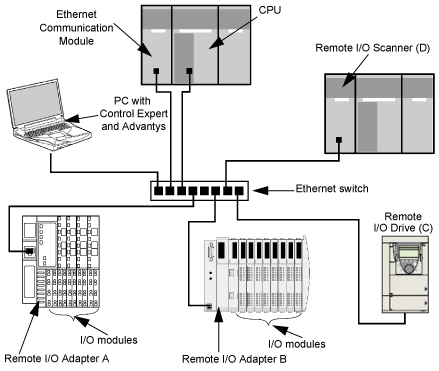|
Projecting Ethernet Network Performance
|
|
|
Original instructions
|

|
Device
|
Load Limits
|
Bandwidth Limits
|
|---|---|---|
|
Ethernet Communication Module
|
12000 pps
|
80 Mbps
|
|
I/O Adapter (A)
|
8000 pps
|
70 Mbps
|
|
I/O Adapter (B)
|
8000 pps
|
70 Mbps
|
|
I/O Drive (C)
|
8000 pps
|
70 Mbps
|
|
I/O Scanner (D)
|
12000 pps
|
80 Mbps
|
|
Switch
|
16000 pps
|
90 Mbps
|
|
Device
|
CIP I/O Connections
|
RPI Setting
|
I/O Packet Size
|
|---|---|---|---|
|
I/O Adapter (A)
|
5
|
20 ms
|
8000 bits
|
|
I/O Adapter (B)
|
2
|
30 ms
|
4096 bits
|
|
I/O Drive (C)
|
2
|
30 ms
|
8000 bits
|
|
I/O Scanner (D)
|
2
|
50 ms
|
8000 bits
|
|
Device
|
Number of packets per connection
|
X
|
Number of connections
|
÷
|
RPI
|
=
|
Load
|
|---|---|---|---|---|---|---|---|
|
I/O Adapter (A)
|
2
|
X
|
5
|
÷
|
20 ms
|
=
|
500 pps
|
|
I/O Adapter (B)
|
2
|
X
|
2
|
÷
|
30 ms
|
=
|
134 pps
|
|
I/O Drive (C)
|
2
|
X
|
2
|
÷
|
30 ms
|
=
|
134 pps
|
|
I/O Scanner (D)
|
2
|
X
|
2
|
÷
|
50 ms
|
=
|
80 pps
|
|
Total
|
=
|
848 pps
|
|||||
|
Switch
|
=
|
848 pps
|
|||||
|
Device
|
Packet size
|
X
|
Load
|
=
|
Bandwidth
|
|---|---|---|---|---|---|
|
I/O Adapter (A)
|
8000 bits
|
X
|
500 pps
|
=
|
4 Mbps
|
|
I/O Adapter (B)
|
4096 bits
|
X
|
134 pps
|
=
|
0.554 Mbps
|
|
I/O Drive (C)
|
8000 bits
|
X
|
134 pps
|
=
|
1.07 Mbps
|
|
I/O Scanner (D)
|
8000 bits
|
X
|
80 pps
|
=
|
0.64 Mbps
|
|
Total
|
=
|
6.26 Mbps
|
|||
|
Switch
|
=
|
6.26 Mbps
|
|||
|
Device
|
90% of Load Limit
|
90% of Bandwidth Limit
|
|---|---|---|
|
Ethernet Communication Module
|
10800 pps
|
72 Mbps
|
|
I/O Adapter (A)
|
7200 pps
|
63 Mbps
|
|
I/O Adapter (B)
|
7200 pps
|
63 Mbps
|
|
I/O Drive (C)
|
7200 pps
|
63 Mbps
|
|
I/O Scanner (D)
|
10800 pps
|
72 Mbps
|